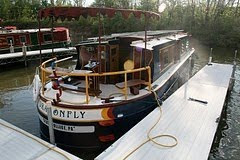 |
| A vintage 1930s, bascule-type, cast-iron bridge opens for a "tow" in downtown Joliet |
So yo, check out THIS big boy (photo at right).
This is what folks here on the river call a "tow." A tow consists of one to nine barges (there are six in this tow--it's two barges wide and three barges long) that, strictly speaking, are not actually towed; they are nudged along by a very large, tugboat-like vessel (which is out of the frame in this picture).
And yuh, the boat that's moving these barges around looks like a tugboat, but don't call it a tug--it's a towboat. Towboats and their associated barges are big and heavy and made of steel and move slowly--kind of like us.
We stayed two days at the town dock in Joliet, Illinois, and daytime, nighttime, 24/7, we saw these big tows moving past us on the Illinois River.
Pulled by two mules, the original canal boats were slow--but keep 'em moving, 24 hours a day, 7 days a week, and they cover a lot of ground. The premise still works today.
Our current boating "Bible" is Cruising Guide from Lake Michigan to Kentucky Lake, the Heartland Rivers
Route by Captain Rick Rhodes. Cap'n Rick includes a handy little concise chapter on towboats at the front of the guide, so recreational boaters will know how to deal with them safely and appropriately . . . which is good, because the first time you see a tow moving slowly and inexorbably toward you round a bend in the river, so enormous it exerts the gravitational pull of Jupiter, your untrained reaction is to freeze in absolute terror.
But remember, big = good. Here's what I learned from Cap'n Rick.
 |
| We've seen several barges carrying benzene. It's a solvent used when producing plastic, synthetic rubber, and dyes |
There are more than three thousand towboats that together move about 21-thousand barges on America's inland waterways. Each year, the tows transport about 1.4 billion metric tons of cargo--mostly grain (including corn, wheat, oats, barley and rye) and petroleum products (fuel oil, lubricating oil, kerosene, and gasoline--plus coke and coal)
"Hey," you say. "I thought most of America's stuff moves by truck." True. Trucks hauled about 11 billion tons of stuff across the nation in 2006. (Trains are in the equation too. They haul about 25% of all U.S. freight)
But here's the cool thing about tows: A single towboat and its barges can carry many, many times more cargo than a single rail car or truck. How much more? A typical tow, three barges wide and five barges long (that's 15 barges total) carries as much as two and three-quarters miles worth of freight cars . . . as much as 12 miles of tractor trailers, placed end to end on the interstate.
 |
| How far can YOU go for $3.39? |
And tows are vastly more economical than trains or trucks. Indeed they're one of the most economical forms of transportation in existence. A tow pushing its load of barges consumes, on average, 2400 gallons of fuel a day . . . which works out to one gallon of fuel for each ton of cargo moved 500 miles.
(If you are not sure whether that's a good number, ask yourself how heavy a load a Ford F-150 can haul on one gallon of fuel . . . and how far.)
FedEx advertises that you should use its services "when you absolutely, positively need it tomorrow." But when there's no rush (and hey, it's not like petroleum is going to spoil or otherwise become less valuable during a long trip) a tow is the way to go--demonstrating the great, big, enormous power of slowness.





No comments:
Post a Comment